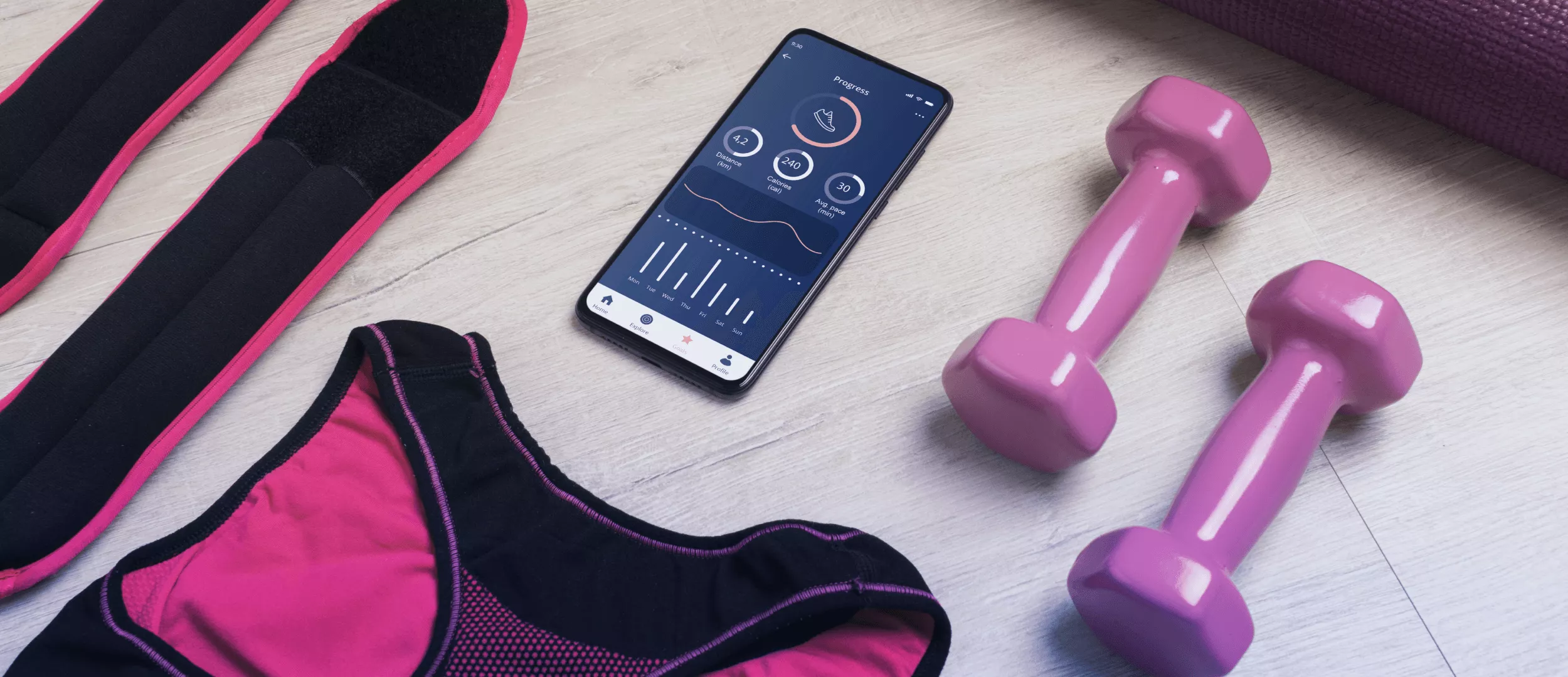
Health and fitness app development focuses on creating tools that promote physical activity and help users reach wellness goals. They are tools that can be downloaded on mobile devices, like smartphones and tablets, and used for training and getting fit.
With COVID-19, fitness apps have become incredibly popular. Partly it happened because of a global lockdown. People looked for opportunities to exercise, do sports, workout, and train when the gyms were closed. Partly it was because individuals paid more attention to their health, lifestyle, nutrition, and diet.
As a type of healthcare solutions, fitness apps help to monitor various health parameters. They are heart rate, saturation, and even blood pressure. They also assist with exercising or other types of physical training. The apps help to track nutrition (calorie intake and macronutrient consumption).
So, digital transformation touched upon fitness applications. They now help users reach their wellness goals (lose weight, build muscle, or increase flexibility) or simply lead a more active lifestyle (track distance traveled, steps made and calories burned).
Digitalization turned fitness apps into progress-tracking tools, motivational reminders, and assistants keeping users motivated on their fitness journey. By combining expert guidance, tracking tools, motivation, and community support, these apps can help individuals establish healthy habits, stay accountable, and work towards achieving their fitness aspirations.
But why develop a fitness app? The answer may be found in the brief overview of the fitness solutions market.
Fitness Apps Market Overview
The COVID-19 pandemic gave the greatest push to the fitness app industry since the Eon of digital transformation started. In 2023 over 858 million fitness app downloads were recorded, with over 368 million users. Though the figures show a slight decrease compared to 2022, the global Fitness Apps market is expected to achieve a market volume of US $10.04bn by 2028. The forecasted growth indicates a CAGR, annual growth rate, of 9.99%. If you follow the best practices of fitness app development spicing your product with the latest trends and a bit of innovation, you can expect up to 28% conversion rate, and above 50% retention rate.
But before answering how to create a fitness app, let's deal with the current trends in this sphere.
What are the biggest trends in fitness apps?
The fast-evolving industry obliges us to stay current, so being in trend is the key. The up-to-date fitness mobile app development trends are:
Integration with wearables.
The increased adoption and popularity of wearables boosted the demand for compatible solutions. While the devices measure and track your heart rate, physical activity, and even the level of stress, the apps that seamlessly integrate with various wearables grow in popularity. They track user data and provide real-time feedback on their condition.
Social engagement and gamification
Modern fitness application developers extensively incorporate social media features and elements of gamification into their solutions. It brings the users fun and encourages engagement. A sense of community is important, especially when reaching similar aims. It may be training, nutrition, or whatever.
Personalization
Personalization is at the heart of developing a fitness app, often powered by AI and ML technologies. They can deliver nutrition advice, personalized training plans, and progress tracking. Individual user preferences and goals are considered and analyzed for better outcomes. So, the users get the sense of a personal trainer in their pocket.
Virtual fitness training
The pandemic of COVID-19 facilitated the popularity of virtual workouts and fitness classes. During the global lockdown many gyms, coaches, and fitness studios offered online training to their clients. The trend still holds on.
The market of fitness apps is going to continue its upward trajectory. The growing health consciousness, increasing wearables' popularity, and technological advancements favor the process. So, consider the trends, the target audience, and the type of solution you want to introduce to the market.
KPI criteria for fitness apps?
As soon as the questions above are answered, think about your application for fitness KPIs. It will prompt you on how to build a fitness app most effectively.
Following the best practices of design and development, you should target (and expect) such results as:
- DAU (daily active users) around 9%-10%,
- Up to 30 % conversion rate. This is how many customers install your app upon discovering it,
- Getting into the top 100 fitness apps with a 5-star rating,
- A 7% retention rate after the 1st month, and strain after an even greater result than that,
- Gaining at least US $2 million per month as the top-grossing fitness apps worldwide do.
Let’s look closer at the types of fitness apps, to give you a better perspective of the opportunities in this field.
Want a web app that does more?
Let's build a solution that's smart, sleek, and powerful.
Alina
Client Manager

Types of Fitness Apps
Activity tracking apps
This kind of applications helps users track and analyze their physical activity. One can also monitor their health parameters throughout the day. These digital tools leverage data collected through the sensors in smartphones or wearables. They are steps, distance, calories burned, quality of sleep, and much more. So, the apps are often integrated with other fitness software or devices. Activity tracking solutions provide real-time insights into daily activity and movement habits. They encourage the users to make healthier choices. Such software allows individuals to set personalized goals and track progress over time. Gamification works well to keep users active with challenges and rewards.
Workout apps
These digital solutions offer a wide range of exercises, workout activities, and training programs. They are in different forms: instructions, guided videos, exercise demonstrations, etc.
A user can find one to their liking and for achieving their fitness objectives. The apps often offer progress tracking, training schedules, timers for rest, social features, and virtual coaching. It supports the users in reaching their goals more effectively.
Diet and nutrition apps
These digital tools help manage daily dietary intake, keep to a healthy and well-balanced diet, and make informed food choices. Diet and nutrition apps have food logging, meal planning, and hydration tracking. They support calories, macro and micronutrient monitoring, nutritional analysis, etc.
These solutions provide valuable insights into the individuals’ nutrient intake, calorie balance, and eating habits, promoting healthy ones.
To ensure that you are well-equipped to navigate the intricacies of software development and build your own fitness app, let’s move on to the key features of such applications.
Fitness Application Features
Workouts
People install fitness apps to get into shape and often lose weight, so a workout planner is the core of many fitness solutions. The implementation of this functionality may vary image-based instructions with voice prompts, videos, or video streams.
It’s vital to differentiate the workouts according to the difficulty level and provide a workout schedule or calendar. It helps the user to create a workout plan app based, yet personalized.
Nice-to-have features for such applications are easy navigation within the exercises, text to text-to-speech engine with multiple languages support, and a workout calendar.
Maps and routes
Outdoor activities like walking, running, and cycling are more convenient to plan, track, and review when you have a map with a routing overlay. So, many fitness apps have GPS tracking functionality.
Consider the integration of the following features to gain a loyal audience:
- key stats' integration, like speed and pace at a glance,
- automatic map markers set up for training achievements,
- highlighting the areas of the track where the individual can do better.
To be competitive in the modern market, consider some unique overlays to add to the map. It may be the weather forecast or air quality, which is extremely important for people sensitive to the latter.
Meal plans and calorie counting
Calorie count and more than that, meal planning can’t be ignored when a fitness or workout app is created. The most advanced solutions offer information about ingredients and prompt dishes and recipes. They are based on the user's eating habits, constitution, and goals.
To develop a fitness app of your own and make it stand out, consider the following:
- Adding barcode scanning and getting nutrition data from external sources,
- Tracking water intake,
- Dynamic adjustment of the recommended meals based on the calories consumed and spent.
Integration with other services and devices
Integration with other services and applications helps to get a more comprehensive picture of user training statistics and progress. So, consider integrating with various trackers, like Fitbit, Apple Watch, and Google Fit to pull data from them.
A good idea is to allow users to train to their favorite music without switching to another app and player. So, integrate your app with Apple Music, Spotify, or other music streaming services.
You may also offer your customer a ready playlist, choosing the tempo that matches heart rate or pace.
Let’s finally proceed to the main questions of how to make a fitness app. Let's look at the quite clear steps to follow.
6 Steps to Create a Fitness App
In creating a software solution, developers follow more or less standardized steps, which can be put more precisely or less. We will now go through this process, describing the steps you need to take.
Research the market
Your main aim here is to understand your target audience and figure out what product you are going to build. In the process of research, you may find out that a user switches between a tablet, a TV, and a wearable throughout the day for various purposes: to put in the calories, to work out, and to check the stats on their wrist, for instance.
So, consider all these device types during fitness app development. The UX for working out at home and training in the gym should also be radically different.
At this stage, it’s also essential to study your competitors, their strong and weak points, and the way they address their audience and user concerns. It will form your unique selling proposition and envision your potential audience.
Plan the app's features
The initial research will help you figure out the essential features you should include in your app. User profiles, personalized workout plans, training libraries, and activity and nutrition tracking are must-haves. You can also consider progress analytics, gamification, and social features. It'll make your fitness app more competitive and engaging.
Choose the tech stack
The knowledge of the target audience and the understanding of their preferred devices will prompt you the tech stack. You should choose the appropriate technologies, tools, and frameworks to create a custom product that will suit the needs of your audience. Whether native or cross-platform fitness app development, scalability and compatibility should be considered early.
Think about the necessary integrations and payment systems to integrate for various needs: to accept from the users, to pay fitness instructors, to receive payments for sponsored apps, etc.
The tech stack is important because it determines the possibilities of the app-to-be. On the other hand, it may set limitations and for sure it influences the budget. Or your budget can determine the tech stack.
Create UI/UX design
The fitness app should be functional. Yet, its design should be appealing, clear, intuitive, and not overloaded with unnecessary elements. Make it easy to navigate and enhance UX. Make sure it’s simple and convenient for users of various fitness levels.
Develop an app
MVP is a good option to test your fitness app concept and get feedback from the users. We advise you to develop this simplified version of your product first. It will allow you to validate its potential.
After you get positive feedback and see what can be enhanced, you can proceed to the development of a more complex solution with all the features initially planned, and user feedback considered.
Launch, market, and promote the app
Launch your app on popular platforms, like Google Play and App Store. Ensure you follow all the necessary guidelines. By, the way, we help Stfalcon clients to do it without much hassle because we know all the nuances of the process.
But it’s not yet the time to relax. If you want your product to grow, market it. Optimize the app store listing with compelling descriptions, attractive visuals, and relevant keywords. Then consider the marketing strategy to reach the target audience and engage it. You may use social media, influencers, and content marketing to grow your audience. At the same time keep the solution up-to-date, adjusting its functionality and adding new features to stay in trend.
How Much Does It Cost to Build a Fitness App?
This question can only be answered when you have a clear understanding of everything above – type of app, target audience and devices, and the features to implement. Then you can discuss the budget with the development team. They would answer the question of how much does it cost to create a fitness app according to your specifications.
The best option is to hire a dedicated development team to carry the project from scratch. Experienced developers from Eastern Europe, specifically from Ukraine, are the best from the cost-quality ratio point of view.
Speaking about rough estimations you’ll need around 80 hours for research, 160 hours for design, over 800 hours for development, 280+ hours for quality assurance, and around 250 hours for project management. So, expect to start with around $ 80,000, but keep in mind that the number of hours and level of developers may vary.
An accurate budget estimation can only be done with precise data about your project and by the vendor company you choose. If you want to know how much to create a fitness app with Stfalcon costs, contact us for your project estimation.
Monetization Strategies
No one approaches fitness app developers without profit goals; strategic monetization is essential. So, it’s crucial to understand the possibilities and strategies to generate revenue and benefit in the long term. This section is devoted to the most popular monetization strategies. You may choose one or several for your fitness app. They are the same as other mobile solutions but with respect to fitness themes.
First, you can offer a free version of your application with basic features for free. Then a paid version or subscription model differentiated for different levels may be proposed. Charge a user one time or offer in-app purchases of your service, premium content, or virtual goods.
Additionally, consider an e-commerce platform for selling sports equipment, clothing, and nutrition.
The other side of the e-commerce store is partnerships with fitness brands, equipment manufacturers, or health companies. You can sell their products and get fees, you can also promote their products. And that is in-app ads you can earn revenue from. However, be careful with advertising not to spoil your UX. Ensure you keep UX consistent. Your primary focus is keeping fit, isn’t it?
Create a Fitness App with Stfalcon
You are lucky to have come across this article and Stfalcon as a fitness app vendor. With our experience in fitness tracker app development, our team successfully delivered the STRONGMom project from scratch.
A client contacted us with a finished fitness app for before, after, and during pregnancy. The users complained about the confusing logic and malfunctions of the platform. The owner was dissatisfied with the admin panel. Stfalcon conducted a thorough project audit and cost assessment. As a result, it was decided to develop the project from scratch.
The main app’s goal is to provide women with all the tools to maintain health and good physical condition before, during, or after pregnancy. It's achieved with the help of video lessons from professional trainers, medical professionals, and other specialists. Our team delivered an optimized app with a fresh design to the client’s great satisfaction.
Conclusion
Adhering to the requirements of ISO 9001:2015, Stfalcon has proven to meet the specified international standards and applicable legal regulations. More than that, our company is well-known for its extensive expertise, professional experience, customer-centric approach, and ability to create custom software solutions that exceed the expectations of our clients and their audience. It happened with the STRONGMom project, so we have proven expertise as a fitness app vendor. We can prompt the best technical solution for your idea. Contact us right now to discuss it, so that we make more people strong, fit, and healthy together.
Below you can find the answers to the most popular questions and then ask us if you still have any.
FAQs about Creating a Fitness App
What is a fitness app?
Fitness mobile apps are tools that can be downloaded on mobile devices and used for training and getting fit. They are often apps for working out at the gym or home that help to track nutrition (calorie intake and macronutrient consumption) and monitor health parameters. If you're planning on building a fitness app, it's important to understand the core functionality these tools typically offer.
What are the key features of a fitness app?
The key features for a mobile fitness solution should be registration and user profiles. The latter should contain personal parameters and preferences in workouts and nutrition. Live streaming and video instructions might also be included. The dashboard, the possibility of goals setting, progress tracking and analytics, reminders and notifications should be implemented in your app along with multiple integration possibilities with third-party apps and wearables. When developing a fitness app, remember about gamification and social features for sharing achievements and added motivation. Apps for fitness challenge should also contain leaderboards and incorporate rewards and badges. It'll make the fitness journey more enjoyable and engaging.
How long does it take to build a fitness application?
You should expect 3 - 6 months to develop a custom fitness application of medium complexity.
How much does it cost to build a fitness app?
If you start from an MVP, expect around $25000-$30000. A full-featured application may cost you from $80000 to $170000 and above, depending on the complexity and technologies (AI, ML, Voice Integration, Video Streaming) you want to implement.

 Read the full case study
Read the full case study


